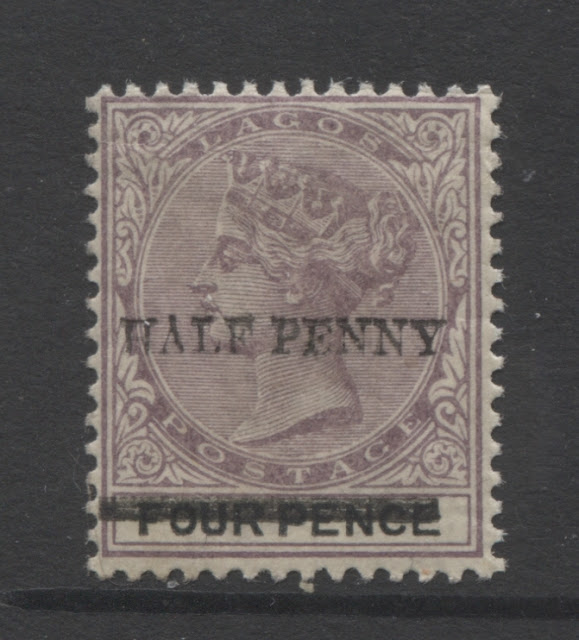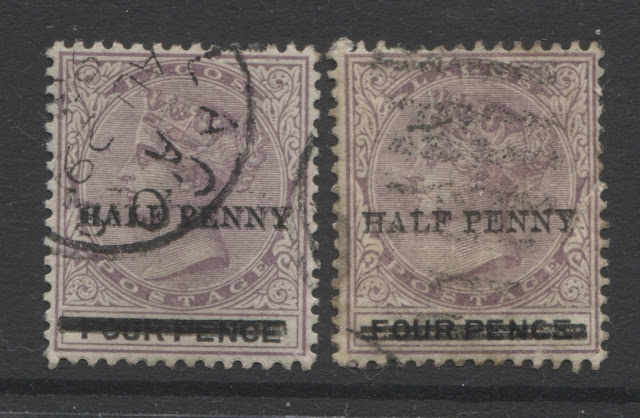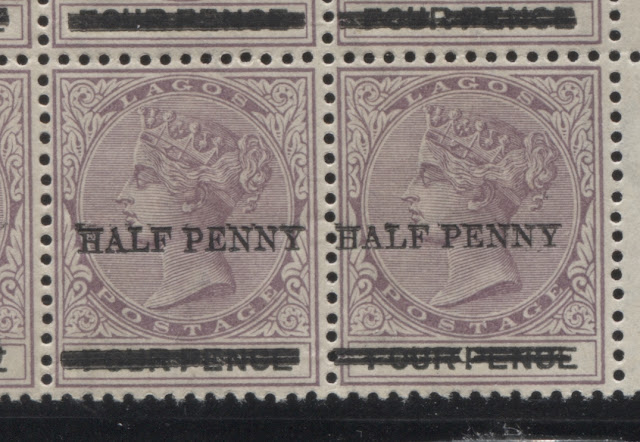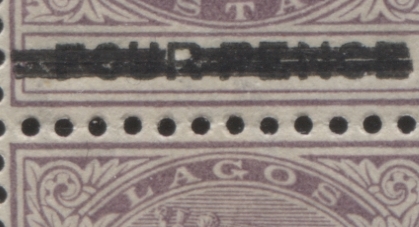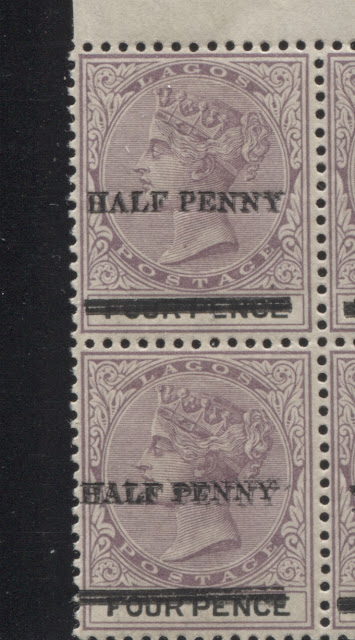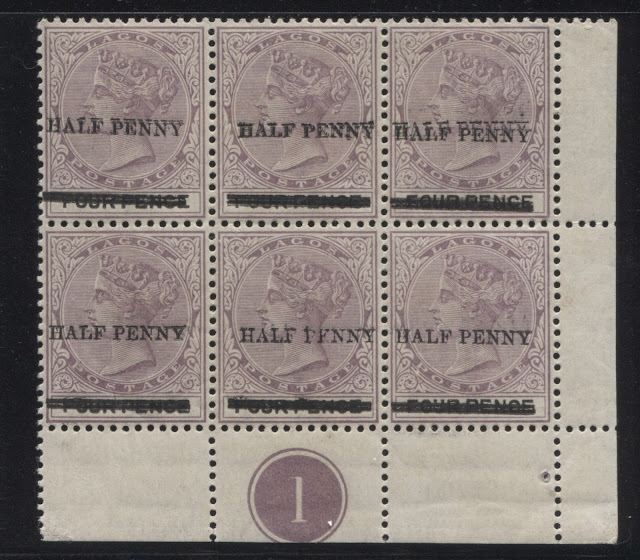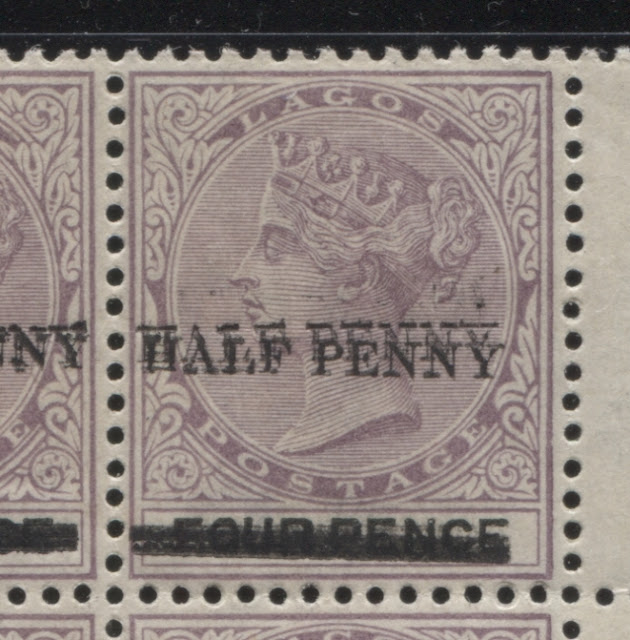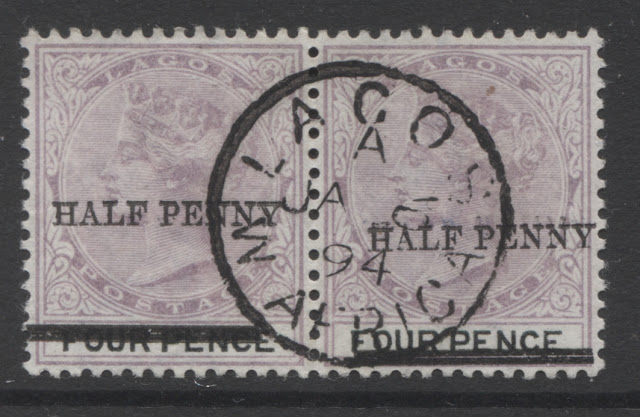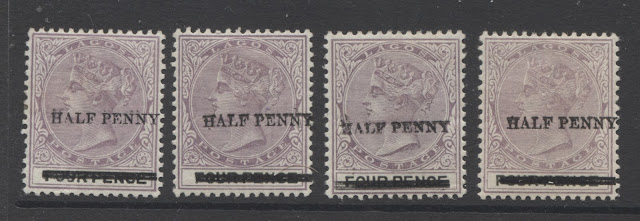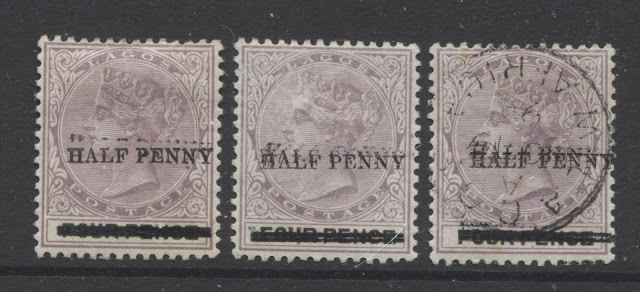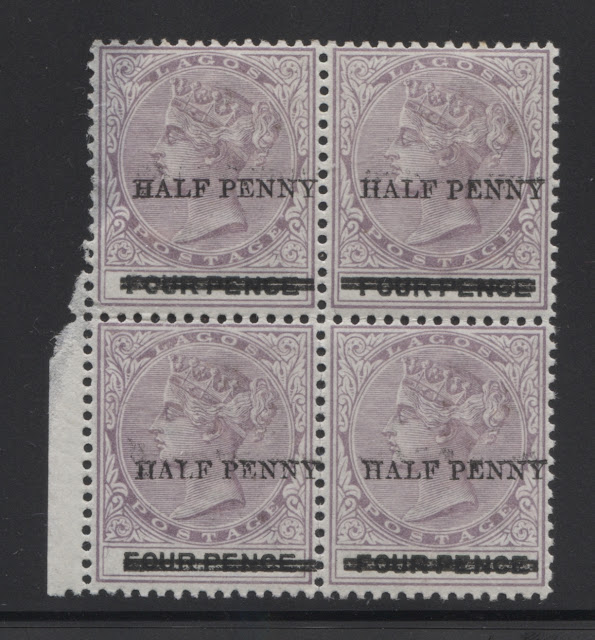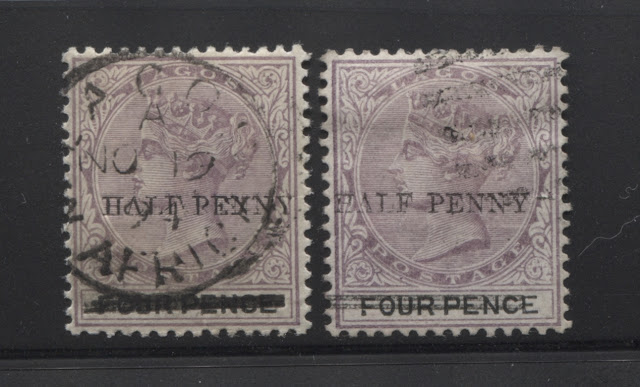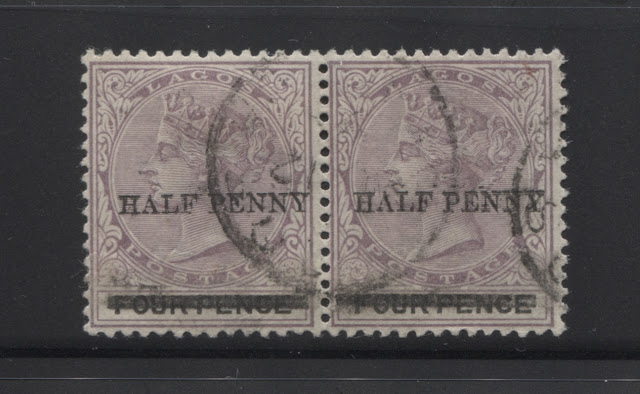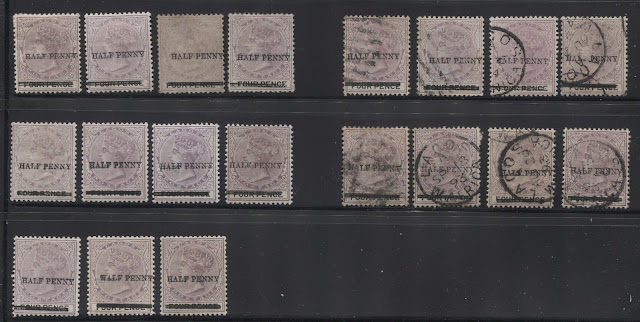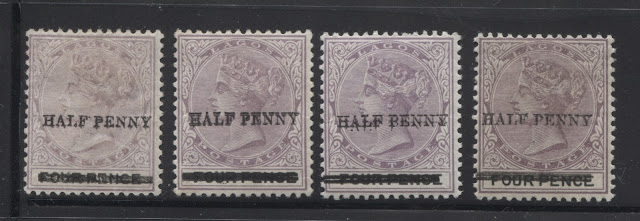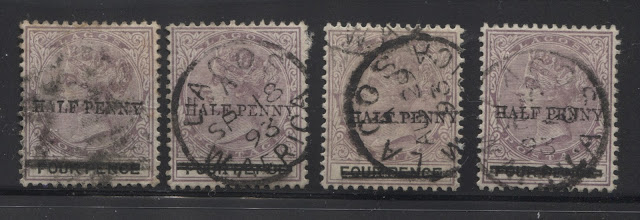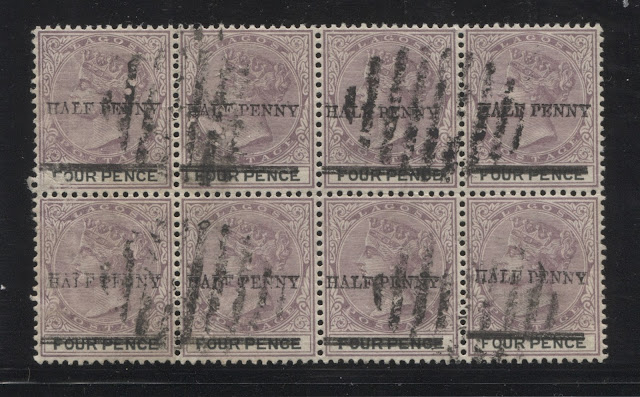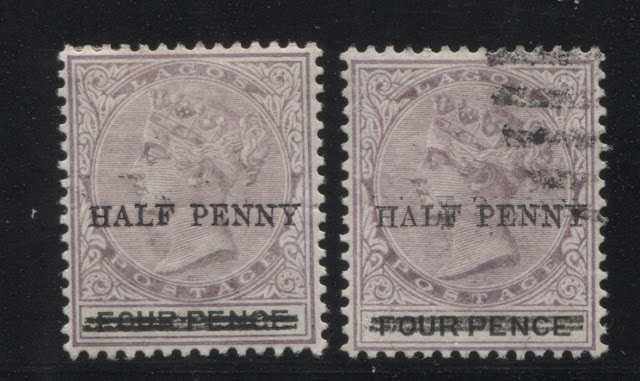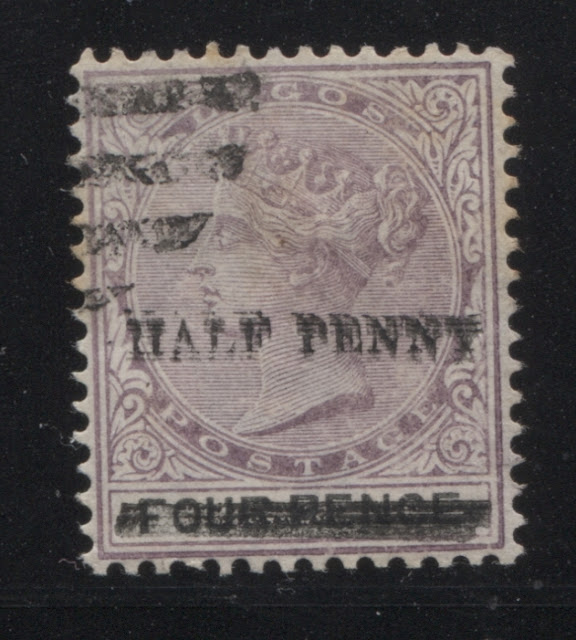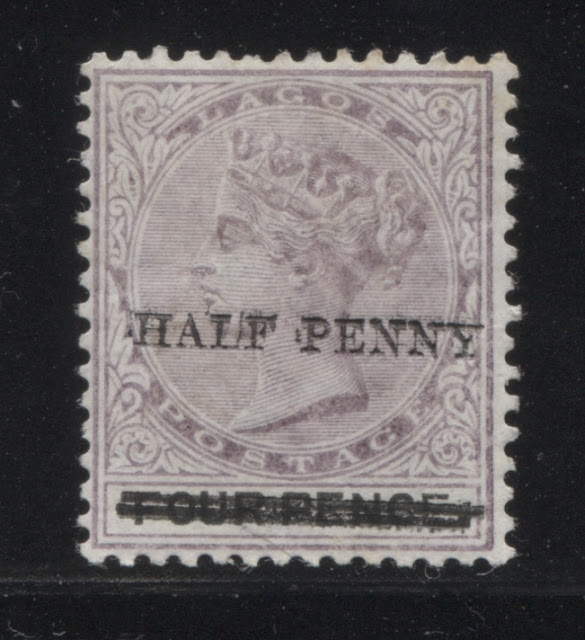Last week I looked at the printings made from the third state of the plate, for the 4d lilac and black Queen Victoria Keyplate stamp of Lagos. This week, I am going to segue a bit and look at the half-penny provisional overprint, which appeared in August of 1893. By way of background, the quantity of halfpenny stamps that were sent to the colony in 1893 was badly mis-judged to the point where, by August 1893, there was a severe shortage of half-penny stamps. So, to alleviate the shortage, over the next six months or so, a quantity of 4d stamps were surcharged with the words "Halfpenny". According to Pemberton, a well known philatelist from the 1930's there were six separate printings of the surcharge, which were made over the six month period before fresh supplies of the halfpenny were received from London. So it is quite likely that there was one printing per month from August 1893 until about February 1894. The total quantity of stamps surcharged is not known with certainty, but it has been suggested in Ince's work that it was approximately 20,000 stamps. What is also not known is which printings were used for the surcharge.
I have a fairly significant quantity of the surcharge on hand, and it would seem to be a useful exercise at this point, to take these stamps and match them up to the printings that I have identified so far. By doing so, I can safely conclude that the stamps without the overprint that share the same characteristics will have been printed before February 1894. This should help isolate those printings that were made between February 1894 and March 1895, since none of those stamps will have a corresponding surcharged example. Furthermore, by studying the printings made over the six month period of the surcharge, it may be possible to identify printings of the 4d that were specifically attributable to the period from August 1893 to February 1894. In this case, I would expect to see a surcharge that always exhibits the same characteristics in terms of plate wear and shade.
So my first step in studying these, before I attempt to match them to the other printings that I have already identified, will be to study the surcharges themselves and attempt to group them into the six printings identified by Pemberton. That will be the focus of this week's post.
First Printing - Made From A Setting of Two - July 1893
In the first printing, the surcharge consisted of repeating pairs of two distinct surcharges. In both cases, the words "Half Penny" are 16 mm long, the space between them is 1.5 mm, and the bars obliterating the words "four pence" are 16.75-17 mm long and placed one above the other in such a way, that neither juts out significantly from the other on either end. The difference between the two surcharges in each pair is as follows:
In my collection, I have a total of 16 stamps displaying this surcharge type. Eleven are mint, and five are used. The scans below show each group of four stamps more closely:
Here is the bottom row of mint examples. Note the similarity of the shades of the first three stamps.
Here is the second row of mint examples from the bottom left. Again, all stamps but the third, which is badly tropicalized are of similar shade.
The top row of used examples. The first stamp from the left bears an October 3, 1893 Lagos CDS, which opens up the possibility of this being from either the first or second printings. The second stamp from the left is cancelled with a lovely August 12, 1893 Lagos CDS, which places it squarely in the first printing, in all liklihood, as the earliest known use for this issue was August 2.
Finally, the two stamps on the end of the block both show very slight doubling of both the letters and the surcharge bars. However, in my opinion, the doubling is not strong enough to constitute a true double surcharge variety, as listed in Gibbons. Here is a close up of those two stamps:
The pair and the single in the middle are both dated January 1894, which is well within the date range given by Pemberton for this printing. The pair however is very curious because it does not correspond to the previously identified types. Let's take a closer look at it:
Here I have 19 regular mint examples of this surcharge, three with doubling of the surcharge, and one with an inverted "V" in place of the "A". The mint examples show a range of shades, which indicates that stamps from several printings made to 1893 were used for the surcharge. I also have six used examples of the regular surcharge, which will be shown below. The number of examples with this surcharge is the largest, which does support the notion that the third printing was indeed, the most common of the six documented.
Here is the first group of mint examples. Note the general misplacement of the letters in relation to the surcharge bars. The more misplaced ones are more likely to be from the third printing, than they are from the fourth printing.
Here is the third group of four mint examples. These are all relatively clean and unbattered, which indicates that they are very likely from this third printing.
Here are the next three mint regular stamps. Here there is a wide range of shades and a considerable amount of slippage in the typeface of the first example on the left.
And the last four of the regular mint examples. The typeface is fairly clean for the first and fourth examples, and quite battered on the second and fourth examples. This would suggest that the first and third examples are likely from the third printing.
Here are three examples that all show some degree of doubling of the surcharge. The first two show no doubling of the bars, and only partial doubling of the letters, but the doubling is far enough upward that it is more spectacular than the usual more common kiss prints. The third used example has a distinct second impression of the entire words, as well as very slight doubling of the bars. This used example appears to be cancelled either in October or November 1894.
The dot inside the P is very clear on all but the last stamp, where it is fainter. However, with a magnifying glass it is clearly visible.
Here are my two used examples, both of which appear to be cancelled with 8-bar oval obliterators.
Now, let's look at surcharge 6. I only have two used examples as shown below:
The stamp on the right is cancelled with an 8-bar oval obliterator, but the left stamp is cancelled with a November 19, 1894 Lagos CDS, which is consistent with this being a later printing.
I have one used pair which consists of surcharge 4, followed by surcharge 1 as shown below. Pemberton had originally asserted that this printing was supposed to consist of surcharge 1-surcharge 2-surcharge 4 in a repeating pattern, but that the actual type used was surcharges 4, 5 and 6 in an indeterminate order. However, the existence of this pair would seem consistent with Pemberton's original findings, and would suggest that it is from the fourth printing:
I have eleven mint singles and eight used singles. The scans below, show each of these groups of stamps more closely:
Here are the first four mint examples. The third stamp is badly faded, but note how the shades of this group are generally paler, or duller than the earlier printings. This suggests that these were made from later printings of the 4d.
Here is the second group of mint examples, with the middle two being kiss prints that show some doubling of the letters.
Here are the last three mint stamps, with the middle example showing a clear kiss print also.
Here are the first four used examples. The first CDS example is cancelled in 1894, but the second one is dated August 1893, which again suggests that this printing may have actually been made concurrently with the others.
Here in this group of four used stamps, we have dates ranging from September 1893-December 1893. So again, it is possible that this printing was made quite a bit earlier than I thought.
Here is a nice mint block of 6, from the left side of the sheet, showing incomplete "LF" of "Half" on the lower right stamp.
You can see that there is a second impression located just below the first, and a third impression located above the first.
I have a fairly significant quantity of the surcharge on hand, and it would seem to be a useful exercise at this point, to take these stamps and match them up to the printings that I have identified so far. By doing so, I can safely conclude that the stamps without the overprint that share the same characteristics will have been printed before February 1894. This should help isolate those printings that were made between February 1894 and March 1895, since none of those stamps will have a corresponding surcharged example. Furthermore, by studying the printings made over the six month period of the surcharge, it may be possible to identify printings of the 4d that were specifically attributable to the period from August 1893 to February 1894. In this case, I would expect to see a surcharge that always exhibits the same characteristics in terms of plate wear and shade.
So my first step in studying these, before I attempt to match them to the other printings that I have already identified, will be to study the surcharges themselves and attempt to group them into the six printings identified by Pemberton. That will be the focus of this week's post.
First Printing - Made From A Setting of Two - July 1893
In the first printing, the surcharge consisted of repeating pairs of two distinct surcharges. In both cases, the words "Half Penny" are 16 mm long, the space between them is 1.5 mm, and the bars obliterating the words "four pence" are 16.75-17 mm long and placed one above the other in such a way, that neither juts out significantly from the other on either end. The difference between the two surcharges in each pair is as follows:
- On the first surcharge there is no serif at the top of the left hand side of the "E", while the "P" is set slightly lower than the "E".
- On the second surcharge, the cross bar at the top of the 'L" slopes down at left. There is virtually no serif to the right of the foot of the right hand vertical stroke of the "H".
Both of these surcharges are found on printings 1-3, so any single stamp with either surcharge, can be from any of these three printings. It is only on pairs or larger multiples that a definite conclusion can be made as to which exact printing the stamps are from.
However, let's take a look at some examples of each of these surcharges:
First Surcharge
In my collection, I have a total of 16 stamps displaying this surcharge type. Eleven are mint, and five are used. The scans below show each group of four stamps more closely:
Here is the bottom row of mint examples. Note the similarity of the shades of the first three stamps.
Here is the second row of mint examples from the bottom left. Again, all stamps but the third, which is badly tropicalized are of similar shade.
The top row of used examples. The first stamp from the left bears an October 3, 1893 Lagos CDS, which opens up the possibility of this being from either the first or second printings. The second stamp from the left is cancelled with a lovely August 12, 1893 Lagos CDS, which places it squarely in the first printing, in all liklihood, as the earliest known use for this issue was August 2.
These four stamps are all examples of the "kiss print", in which the letters of the surcharge show partial doubling, due to movement of the type. They are not true "doubled surcharges", but many collectors mistakenly identify them thus. I will show examples of the true double and triple surcharges, which as you will see are a completely different creature.
Second Surcharge
I have four examples of this surcharge on single stamps, as shown below:
This mint example shows the very clear lack of lower serif at the bottom right of the "H".
This stamp is the first clear example of a doubled surcharge, showing a clear and distinct second impression of the words, and slight doubling of the bars, just visible at the top right.
Here are two used examples, the left stamp being cancelled August 29, 1893, which likely identifies this as an example of the first printing.
I have been able to identify two blocks from this scarce printing, by virtue of the fact that the stamps show both types of surcharge in a repeating pattern of surcharge 1-surcharge 2. In addition, both blocks show some doubling of the surcharge on one or more stamps. In the first block, the doubling is more in the nature of a kiss print, through there is doubling of the bars. In the second block, there is a clear doubled surcharge, showing distinct doubling of all the letters.
Here is the first block:
A lovely block of 6 from the upper right corner of the sheet, showing the "current number" in the selvage, which places this printing from before 1891, as the use of current numbers was abandoned after that date.
Here is a close up of the last two stamps in the second row, clearly showing both surcharge types. The third stamp in the block is one of the types, which proves that the setting consisted of pairs rather than triplets, and thus this is from the first printing. Note how there is a circular flaw in the surcharge bars in both stamps on the right. A close up of this can be seen below:
Finally, the two stamps on the end of the block both show very slight doubling of both the letters and the surcharge bars. However, in my opinion, the doubling is not strong enough to constitute a true double surcharge variety, as listed in Gibbons. Here is a close up of those two stamps:
Now, here is the other block:
This time it is a block of six from the lower right of the sheet. Again, the three stamps show very clearly the repeating pattern of surcharge 1-surcharge 2-surcharge 1 that is characteristic of the first printing.
Here is a close-up of the upper right stamp in the block. Here there is a spectacular doubling of all letters and both bars. This is a true "double surcharge".
Second Printing - Made From the First Triplet Setting - August/September 1893
In this printing, the stamps were surcharged in a pattern of surcharge 3-surcharge 2-surcharge 1, in a repeating pattern, in that order. Now, surcharge 3, has all the characteristics of the basic surcharge, but also with, the "H" set slightly lower than the "A". Unlike the first two surcharges, this third surcharge occurs only on this printing, so singles so identified, can be attributed to this printing.
I have four examples of this surcharge, all of which are used:
The pair and the single in the middle are both dated January 1894, which is well within the date range given by Pemberton for this printing. The pair however is very curious because it does not correspond to the previously identified types. Let's take a closer look at it:
The first thing that stands out about it is that the surcharges are not in the same position vertically, which suggests that this pair shows the end of one overprint forme and the beginning of the next in the setting. The right stamp is clearly the third surcharge, as one can clearly see that the "H" is slightly lower than the "A". But the stamp on the left shows no abnormalities in the letters at all, which as we shall see is characteristic of the seventh surcharge. However, there are no documented instances of a setting consisting of the seventh surcharge and the third surcharges together. This suggests quite strongly that there may have been a seventh printing made of which this might be an example.
Third Printing - Made From The Second Triplet Setting - September/October 1893
In this printing, the setting is made up of surcharge 4-surcharge 1-surcharge 2 in a repeating pattern. According to Pemberton, this printing is believed to be the most common. The key distinguishing characteristic of surcharge 4 is an irregular shaped blot of ink inside the "E" between the top of the letter and the central tongue. This surcharge occurs in the fourth printing also, so it is not possible to assign singles to this printing with absolute certainty.
Let's take a look at the single stamps that I have identified with surcharge 4:
Here I have 19 regular mint examples of this surcharge, three with doubling of the surcharge, and one with an inverted "V" in place of the "A". The mint examples show a range of shades, which indicates that stamps from several printings made to 1893 were used for the surcharge. I also have six used examples of the regular surcharge, which will be shown below. The number of examples with this surcharge is the largest, which does support the notion that the third printing was indeed, the most common of the six documented.
Here is the first group of mint examples. Note the general misplacement of the letters in relation to the surcharge bars. The more misplaced ones are more likely to be from the third printing, than they are from the fourth printing.
Here is the second mint group of four stamps. Note the slippage of the typeface for the "H" in the second and fourth examples.
Here is the third group of four mint examples. These are all relatively clean and unbattered, which indicates that they are very likely from this third printing.
Here are the next three mint regular stamps. Here there is a wide range of shades and a considerable amount of slippage in the typeface of the first example on the left.
And the last four of the regular mint examples. The typeface is fairly clean for the first and fourth examples, and quite battered on the second and fourth examples. This would suggest that the first and third examples are likely from the third printing.
Here are three examples that all show some degree of doubling of the surcharge. The first two show no doubling of the bars, and only partial doubling of the letters, but the doubling is far enough upward that it is more spectacular than the usual more common kiss prints. The third used example has a distinct second impression of the entire words, as well as very slight doubling of the bars. This used example appears to be cancelled either in October or November 1894.
Here we have a used example that shows incomplete lettering in the "A", "L" and "F" of "Half". The "A" actually resembles an inverted "V" as there is no crossbar to the "A". It is the only such example that I have seen in all my surcharged stamps.
Here are my six used examples. What is curious about these is that the two stamps are both dated in August 1893, which suggests that this printing was made much earlier than I thought. However, in both these examples there is slight slippage of the typeface in the upward direction, so that what appears at first to be the characteristic irregular dot of colour in the upper part of the "E", may in fact be the crossbar of the "E" which has been doubled and shifted upward, in which they may be kiss print examples of the seventh surcharge. The third example at the top is dated October 1893, which is about what I would expect for this printing. The other two used examples on the to row are both cancelled with barred oval obliterators, but it is not possible to be certain if they are 8 or 9-bar. The last example at the bottom right is a late usage, cancelled with the wider Lagos CDS, dated February 20, 1901.
I have one mint block of four in which all four stamps appear to be surcharge 4. However, according to Pemberton's studies of this stamp, the fourth surcharge is supposed to be followed either by surcharge 1, 5 or 6. So the existence of this block is somewhat of a mystery:
Fourth Printing - From the Third Triplet Setting - October/November 1893
In this printing, the setting consists of surcharge 4, 5 and 6 together in a repeating pattern. However, the order in which these surcharges appear is not known. What is known is that the typeface is generally the most battered in appearance, though it usually perfectly centered over the bars. The distinguishing characteristics of surchages 5 and 6 are as follows:
- Surcharge 5 has a smudged dot in the centre loop of the "P".
- Surcharge 6 has almost the same characteristics as surcharge 2, except that the letters "N", "N" are spaced wider apart than normal. Normally, the tops of the two "N's" almost touch, whereas with this type, there is an actual space between them.
Surcharges 5 and 6 only occur on this printing, so any single stamp with this surcharge is from this printing.
Let's take a look at my examples of surcharge 5:
The dot inside the P is very clear on all but the last stamp, where it is fainter. However, with a magnifying glass it is clearly visible.
Here are my two used examples, both of which appear to be cancelled with 8-bar oval obliterators.
Now, let's look at surcharge 6. I only have two used examples as shown below:
The stamp on the right is cancelled with an 8-bar oval obliterator, but the left stamp is cancelled with a November 19, 1894 Lagos CDS, which is consistent with this being a later printing.
I have one used pair which consists of surcharge 4, followed by surcharge 1 as shown below. Pemberton had originally asserted that this printing was supposed to consist of surcharge 1-surcharge 2-surcharge 4 in a repeating pattern, but that the actual type used was surcharges 4, 5 and 6 in an indeterminate order. However, the existence of this pair would seem consistent with Pemberton's original findings, and would suggest that it is from the fourth printing:
Fifth Printing - From Last Triplet Setting of 16 mm Spacing - November/December 1893
In this last printing, the entire setting consists of surcharge 7, in which the letters show no abnormalities, apart from the occasional broken letter, or the usual kiss prints and doubling.
Here are the examples in my collection, including a used strip of 6 on piece, a mint block of 6, and a used block of 8:
I have eleven mint singles and eight used singles. The scans below, show each of these groups of stamps more closely:
Here are the first four mint examples. The third stamp is badly faded, but note how the shades of this group are generally paler, or duller than the earlier printings. This suggests that these were made from later printings of the 4d.
Here is the second group of mint examples, with the middle two being kiss prints that show some doubling of the letters.
Here are the last three mint stamps, with the middle example showing a clear kiss print also.
Here are the first four used examples. The first CDS example is cancelled in 1894, but the second one is dated August 1893, which again suggests that this printing may have actually been made concurrently with the others.
Here in this group of four used stamps, we have dates ranging from September 1893-December 1893. So again, it is possible that this printing was made quite a bit earlier than I thought.
Here is a nice used strip on piece. Used examples of this setting were not known when Pemberton published his findings in the mid 1930's.
Here is a nice mint block of 6, from the left side of the sheet, showing incomplete "LF" of "Half" on the lower right stamp.
And finally, a nice used block of 8, cancelled with four strikes of a 9-bar oval obliterator.
The last item I have from this printing is perhaps the most spectacular. It is a mint strip of three showing bad slanting of the surcharge, as well as doubling, including two separate and distinct sets of surcharge bars, on two stamps and a full double surcharge on the third stamp:
Sixth Printing - Made From a New Triplet Setting - December/January 1894?
On this last printing, the words "Half Penny" measure 16.5 mm wide instead of 16 mm. and the space between the words is 2 mm instead of 1.5 mm. The bars of the surcharge are not of even length. The setting is made up of three surcharges in a repeating pattern: surcharges 8, 9 and 10:
- Surcharge 8 has a upper bar measuring 16.5 mm, and lower one 17 mm, with the later projecting slightly at each end.
- Surcharge 9 has both bars 16.5 mm, with the upper one jutting slightly to the right.
- Surcharge 10 has the upper bar measuring 17 mm and the lower one being 16.5, with the lower one overlapping slightly at the left, and the upper one overlapping at right.
I have one mint example of each surcharge and two used examples of surcharge 9, one of which is a bona-fide triple surcharge.
The scans below show each of these:
Surcharge 8. Note how the top bar protrudes slightly at the right.
Surcharge 9 - here you can see the top bar protrude slightly at the right also, but with this type, the bars are the same 16.5 mm width.
Here is the triple surcharge. The tripling involves both the bars and the words. The spacing of the impressions is very close, but it is distinct, as the close up scan shows:
You can see that there is a second impression located just below the first, and a third impression located above the first.
Lastly, surcharge 10, in which the top bar is longer than the bottom, and overlaps considerably on the right.
These last five stamps are of the utmost rarity, given that there were likely fewer than 20,000 stamps in the entire issue and this post today has presented over 100 of them. Out of more than 100 stamps, only five were of this later setting - that is less than 5% of the total printing, so probably less than 1,000 stamps, distributed among 3 different types of surcharge. That triple surcharge may well be unique, or at least one of a very few in existence.
This concludes my classification of the half-penny surcharged stamps into printings. Next week, I will attempt to match these stamps up to the printings of the 4d that I have identified thus far to see if I can narrow down the dates of some of them.







